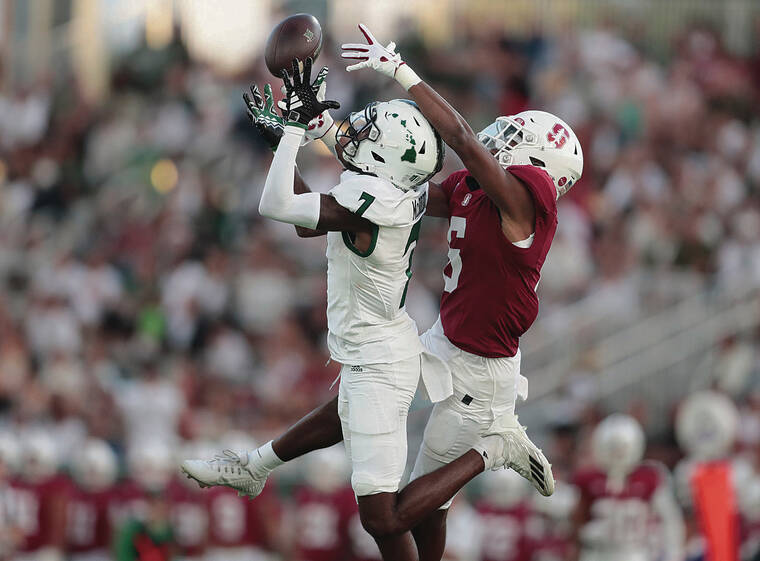The University of Hawaii football team has played two games. That is two more than most of the rest of the college football world, which gets going today.
But despite the two-game headstart, UH had forced as many opponent turnovers as all of those teams that didn’t play until today.
Zero.
The Warriors played well enough in a loss at Vanderbilt last week for the betting line against Stanford in Friday’s home opener to shrink to nearly pick ’em.
But that was one of the problems for UH in Friday night’s 37-24 loss to the Cardinal: The Warriors didn’t pick ’em — as in picking off passes. They haven’t recovered — or forced — any fumbles by their two opponents, either.
You can give Stanford and Vanderbilt credit for taking care of the ball if you want. But one of my main takeaways from these first two games is that UH needs exactly that — some takeaways.
Hawaii had two players ejected from the game for targeting. I know it’s easier said than done in a full-speed collision sport, but the Warriors must aim for the ball, not their opponent’s helmet.
>> RELATED: Hawaii’s mistakes and Stanford’s new looks lead to another loss
>> PHOTOS: Hawaii vs. Stanford
Linebacker Logan Taylor, who led UH with nine tackles, knows that, too.
“We gotta do it at practice to do it at the game, make it a bigger emphasis,” said Taylor, referencing the rule of thumb that if you’re the second defender to the scene you go for the ball if possible.
Hawaii didn’t turn the ball over itself against Stanford, but there were plenty of mistakes. It’s hard to beat anyone with 10 penalties for 107 yards.
“That’s going to be a big emphasis,” Taylor said. “You can’t let your emotion (take over). If it’s close, don’t do it. But we’re definitely not going to stop our intensity. We’re going to keep after it.”
I’ll always remember how UH defensive coordinator Kevin Lempa would smile ear-to-ear after games, even if the opponents gained 600 yards and scored a huge number of points (but not enough to win). The yards and even the points didn’t matter, he’d say — because a pick-6 or a clutch third- or fourth-down stop was often the difference in the game, sometimes the biggest play in a Hawaii win.
That’s often how it works with high-risk, high-reward offenses like the run-and-shoot. Force mistakes that get your team the ball back and you have a much better chance to win.
Hawaii coach Timmy Chang knows this better than most. He lived it 20 years ago as a UH quarterback in the run-and-shoot. Those NCAA passing records he set and his three winning seasons as a starter were partly thanks to a defense that forced fumbles and grabbed opposing passes out of the air with regularity.
“Turnovers do help,” Chang said. “Getting them off the field, forcing them to punt.”
Stanford wasn’t great on third down (7-for-14), but it got the job done on first or second down enough for that not to matter. The Cardinal capitalized on all five visits to the red zone; UH failed to score in one of its three forays beyond the Stanford 20, and had to settle for a field goal on another.
For the second game in a row the passing attack improved as the game went along. Quarterback Brayden Schager found 11 different receivers, but was also sacked six times.
There’s an advantage to having played a game when your opponent hasn’t yet. But there’s another side of that, especially when the other team has a new coaching staff.
“We didn’t know what they were going to do. They came out in some different stuff,” Schager said. “At the end of the day I gotta get the ball out of my hands quicker. I don’t think any of those sacks were on the O-line.”
The largest crowd (12,547) ever to watch a sports event in person on the UH campus did not leave with a win for the home team.
But I think the fans will be back in force, anyway. The only complaint I heard was that it took too long to get a beer. The lines at the food trucks were long.
That, like most of the team’s problems at this point, is fixable.




